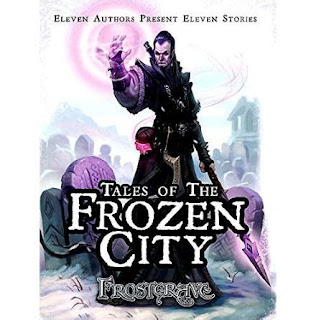After running through all of the rulebooks and supplements over the last week or so, I thought that I should mention the one work of fiction I have from the Frostgrave collection. I received this book as part of the "Nickstarter" I invested in way back when Frostgrave first came out. There are several novels written too, but this book is slightly different in that it offers eleven short stories. I may look into purchasing the novels for my Kindle (if available) in the not too distant future.
Whilst searching the net for a suitable picture of the book cover, I noticed several images showed the tag line "ten authors present ten stories" instead of the eleven stories which my version has. I thought this intriguing but have yet to explore whether this earlier version was actually released (not that I would buy it as I already have the eleven story version, but just for finding out the story).
I have literally just re-read "Tales" (Thursday and Friday evening after work), and feel that I can now start my own adventures in Felstad using the tome as inspiration. I will try to write the weird tales of my own wizard/apprentice and their hardy warband in a similar format so that it doesn't just sound like a write-up of a game session. I kind of tried that with my DnD sessions a few years back and was partially successful (for me anyway), but I have a lot to learn about writing fiction; especially how to write dialogue - hence why I have avoided writing any up until now.
I am hoping that my next post will detail my own warband made up from my very old fantasy figures collection that I used to use back in the day for playing a variety of RPGs. I have plenty of wizard miniatures, as well as thieves, fighters and barbarians, so should have enough choice to make up a decent looking bunch. My issue, as mentioned previously, is a lack of painted adversaries.
Anyway, I digress. This post is about the eleven story collection book and what it offers as a "supplement" to the game.
I was thinking, when I first picked up the book, that each story would be centred around a particular kind of wizard, taking each school in turn, but that does not seem to be the case (or maybe it was and I was just too dense to realise?). Many of the wizardly types are covered (not that I paid too close attention to numbers of each type, because I read the tales for the stories and ideas) but some seem to appear more than others; especially chronomancers.
Each tale is only about 5-10 pages long, so the book can be read in short bursts with each session allowing one to read a complete story or two if so desired. The different writing styles add to the mystique of the stories, and as each author has their own wizardly story to tell there is a lot of variety in the types of story told.
The book is a little pricey (£6.99) for only eleven short stories, but the quality is what we have come to expect from Osprey, so I can overlook that minor point. The only main quibble I have though is that there are no colour plates within the covers; just a small pencil sketch of a wizard at the beginning of each story. These are all very nice, but I would have preferred a few more big pictures in order to fuel my imagination. That said, production costs of a book like this are probably high enough already.

No comments:
Post a Comment